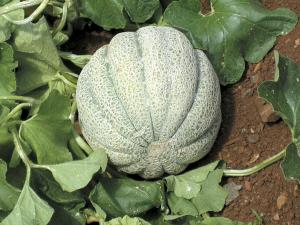Old-Fashioned watermelons and radishes - oh my!
As the quintessential bad gift, nothing beats a bad necktie. Huge so that you aren’t wearing a tie as much as a hideously colored apron. But what is old is new again, and for a retro look nothing beats a bad necktie, if only in an ugly-Christmas-sweater kind of way.
Gardens, like ties, seem to go in cycles with out-of-date, old-fashioned vegetables coming back into fashion, often as much as a novelty or nostalgia piece and sometimes as a new vegetable. While most melons are grown to be eaten fresh, a Minnesota grandmother grew a six ounce softball-sized brilliant orange yellow melon that was sliced thin to substitute for half the filling of an apple pie. Mother Mary’s Pie Melon (Cucumis melo) is now available for 2015. You can eat the melon out of hand, though it is only moderately sweet, with a sharp flavor. For best eating quality pick them when they are just beginning to turn ripe. The fragrant melons are remarkably uniform in size.
Grow Mother Mary’s Pie Melon much like any other cantaloupe in full sun well draining rich soil with a pH from 6.0 to 6.5. If your soil is too acidic or not acidic enough your melon plants will have yellow leaves, fewer flowers and fewer fruits.
Plant four seeds each in hills three to five feet apart. They are quick growing producing high yields of melons in just 75 to 85 days.
Another melon that is better cooked than fresh is the Schochler Watermelon (Citrullus lanatus) whose oblong fruit hides pink flesh and tan and white seeds. This variety was originally developed by J. Palmer Schochler of Rusk, Texas, who by 1925, had about 600 acres planted in Schochler melons. It is not the mildly sweet flesh, but the very thick rind of the Schochler Watermelon that makes it worth growing, but those big thick rinds that are ideal for making pickled watermelon rind and watermelon rind chutney. So grow a watermelon for the rind not the flesh.
To plant watermelons, wait until the ground has warmed to at least 70 degrees to plant Schochler watermelon. Sow the seeds an inch deep in hills of four or five seeds per hill. Space the hills about five feet apart.
Choose a spot with full sun and rich soil with a pH between 6.0 and 6.8. Schochler watermelons ripen in 90 to 100 days after planting. With Schochler watermelons you get fresh watermelon and pickled watermelon rind from one fruit.
And finally there is that radish that breaks the rules, and we love it all the more. Rather than eat just the root of the Rat Tail Radish (Raphanus sativus var. caudatus) you wait for it to bloom and form long, slender seed pods that can be stir fried, sautéed or eaten raw like spicy snap beans. The botanical name literally means “radish with a tail.” You can even pickle the pods or add them to curries. Chopped, they are a good addition to tacos and all Mexican food. The pods grow up to six inches long, but will be most tender before they mature.
Sow Rat Tail Radish in a pot indoors or sow outdoors as soon as your soil can be worked in the spring. There is some discussion as to the proper soil pH for radishes with some recommending a pH of 5.2 and 5.6 in muck soils, but a pH of 6.0 to 6.8 in mineral soils.
Plant the radishes in full sun and you will have flowers and pods in just 50 days. Sow more Rat Tail radish every three to four weeks through the growing season right into fall for a continuous harvest.
Seeds are available for all three of these from specialty seed sources such as Seed Savers Exchange (www.Seedsavers.org) and Baker Creek Seeds (www.Rareseeds.com) among others.
So try something different in your garden this year which is to say try something old-fashioned like Mother Mary’s Pie Melon to stump your next apple pie eaters, or Schochler Watermelon for big thick pickled watermelon rinds, and Rat Tailed Radish just so you can tell your kids that they’re eating rat tails. Consider it payback for the years of bad neckties.



















































